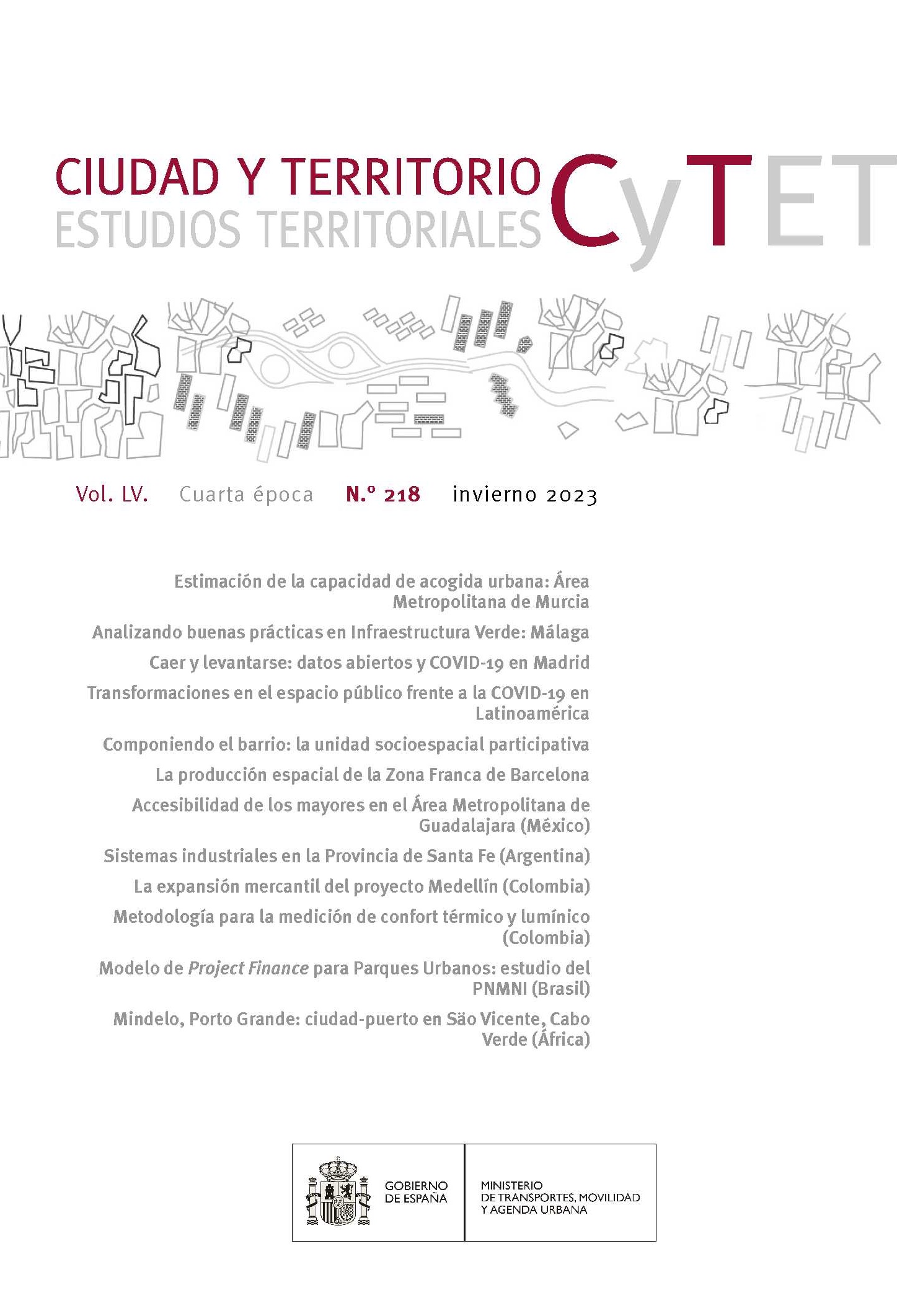Methodology for obtaining the quantitative indicators of the Spanish Urban Agenda: the case of Pamplona
DOI:
https://doi.org/10.37230/CyTET.2023.218.17Keywords:
Spanish Urban Agenda, Quantitative Indicators, Methodology, Regeneration, PamplonaAbstract
The Spanish Urban Agenda, approved on February 22, 2019, represents a new way of working and thinking for the intervention of the city, based on the ten strategic objectives that are presented and that respond to cross-cutting issues for urban planning, in order to achieve more sustainable cities. To this end, a series of monitoring and evaluation indicators are collected, both qualitative and quantitative, to recognize and confirm the scope of the projects and strategies developed in each city. The objective of the article is to identify those indicators that can be obtained in a georeferenced manner and to reach a methodology for obtaining them. The study is carried out in the city of Pamplona, for which several conclusions are obtained, such as the indispensable knowledge of the city for a truthful interpretation of the indicators.
Downloads
References
BEKARIAN, S. (2020, 28 junio): Use of k-means clustering to extract urban typologies in neighborhoods. IAAC Blog. https://www.iaacblog.com/programs/k-means-clustering-for-urban-typologies/
CLEMENS, R. (2018): QGIS Network Analysis. https://root676.github.io/index.html
Diario de Noticias de Navarra (2022): Pamplona es la quinta ciudad del Estado en plazas para la recarga de coches eléctricos. Periódico digital. https://www.noticiasdenavarra.com/navarra/2022/03/25/pamplona-5a-ciudad-plazas-recarga-2088794.html
GOBIERNO DE NAVARRA, Departamento de Desarrollo Rural y Medio Ambiente. (2020): Planes de Acción de Ruido de la Aglomeración Urbana de la Comarca de Pamplona. https://gobiernoabierto.navarra.es/sites/default/files/redpar3-acp-informacion-publica.pdf
HERNÁNDEZ AJA, A & MATESANZ PARELLADA, Á. & GARCÍA MADRUGA, C. & ALGUACIL GÓMEZ, J.& CAMACHO GUTIÉRREZ, J. & FERNÁNDEZ RAMÍREZ, C. (2015): Atlas de Barrios Vulnerables de España: 12 Ciudades 1991/2001/2006. Vol. 01, 02, 03. Instituto Juan de Herrera, Madrid. ISBN 978-84-9728-518-6. http://oa.upm.es/34999/
LACILLA, E.& HERNÁNDEZ, S. & BERGASA J.R. (2022): Las actuaciones estratégicas como instrumento de adaptación y flexibilización en la planificación de la ciudad. En Actas del V Congreso ISUF-H “Ciudades espontáneas versus ciudades planificadas: distintos retos, distintas realidades”, p. 241. Prensas de la Universidad de Costa Rica
MATA, R. & OLCINA, J. & BOUAZZA, O. & TROVATO, G. & COLLADO, L.Á. & DE SANTIAGO RODRÍGUEZ, E. (invierno 2019): Ciudad y Territorio, Estudios Territoriales. Agenda Urbana Española. Vol. LI. Nº202. https://recyt.fecyt.es/index.php/CyTET/issue/view/3774/548
Ministerio de Transportes, Movilidad y Agenda Urbana, MITMA: Análisis urbanístico de Barrios Vulnerables en España. 31201 – Pamplona/Iruña. http://habitat.aq.upm.es/bbvv/municipios/31201.pdf
Ministerio de Transportes, Movilidad y Agenda Urbana, MITMA (2019): Agenda Urbana Española (AUE). https://www.aue.gob.es/
NATERA OROZCO, L.G. & BATTISTON & IÑIGUEZ, G & SZELL, M. (2020): Data-driven strategies for optimal bicycle network growth. The Royal Society Publishing. https://doi.org/10.1098/rsos.201130
Navarra.com (2021): Pamplona inaugurará 34 plazas para recargar vehículos eléctricos: estas son sus ubicaciones. Periódico digital. https://navarra.elespanol.com/articulo/pamplona/energia-coche-electrico-pamplona-recarga/20210616125828369425.html
PAISAJE TRANSVERSAL (2013): «[InPar]: Indicadores participativos. Herramienta para la auditoría social de la sostenibilidad urbana». Planur-e: Transformando territorios y lugares, n. º 1. Madrid: Planur-e Ediciones.
SORRIBES, J & PERELLÓ, S. (2003–2004): Hacia un sistema de indicadores de vulnerabilidad urbana. Revista Castellano-Manchega de Ciencias Sociales, nº 6, 1–17. https://doi.org/10.20932/barataria.v0i6.251
Published
How to Cite
Issue
Section
License
Copyright (c) 2023 Elena Lacilla Larrodé, Ángela Abascal Imízcoz, Íñigo Yangüas Elorz

This work is licensed under a Creative Commons Attribution-NonCommercial-NoDerivatives 4.0 International License.
Considering the provisions of the current legislation on Intellectual Property, and in accordance with them, all authors publishing in CyTET give -in a non-exclusive way and without time limit- to the Ministry of Transport, Mobility and Urban Agenda the rights to disseminate, reproduce, communicate and distribute in any current or future format, on paper or electronic, the original or derived version of their work under a Creative Commons Attribution-NonCommercial-NoDerivative 4.0 license International (CC BY-NC-ND 4.0), as well as to include or assign to third parties the inclusion of its content in national and international indexes, repositories and databases, with reference and recognition in any case of its authorship.
In addition, when sending the work, the author(s) declares that it is an original work in which the sources that have been used are recognized, committing to respect the scientific evidence, to no longer modify the original data and to verify or refute its hypothesis. Author(s) also declare that the essential content of the work has not been previously published nor will it be published in any other publication while it is under evaluation by CyTET; and that it has not been simultaneously sent to another journal.
Authors must sign a Transfer of Rights Form, which will be sent to them from the CyTET Secretariat once the article is accepted for publication.
With the aim of promoting the dissemination of knowledge, CyTET joins the Open Journal Access (OA) movement and delivers all of its content to various national and international indexes, repositories and databases under this protocol; therefore, the submission of a work to be published in the journal presupposes the explicit acceptance by the author of this distribution method.
Authors are encouraged to reproduce and host their work published in CyTET in institutional repositories, web pages, etc. with the intention of contributing to the improvement of the transfer of knowledge and the citation of said works.








 Enlace a CyTET en Linkedin
Enlace a CyTET en Linkedin